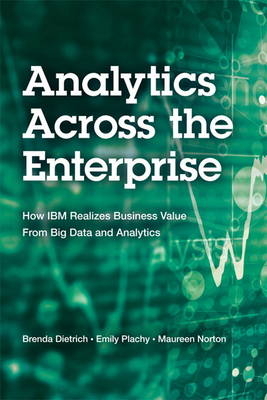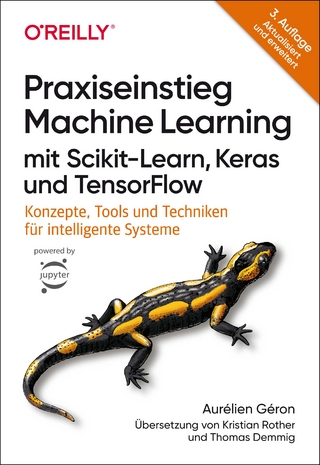
Analytics Across the Enterprise
IBM Press (Verlag)
978-0-13-383303-4 (ISBN)
- Titel ist leider vergriffen;
keine Neuauflage - Artikel merken
Analytics is not just a technology: It is a better way to do business. Using analytics, you can systematically inform human judgment with data-driven insight. This doesn’t just improve decision-making: It also enables greater innovation and creativity in support of strategy. Your transformation won’t happen overnight; however, it is absolutely achievable, and the rewards are immense.
This book demystifies your analytics journey by showing you how IBM has successfully leveraged analytics across the enterprise, worldwide. Three of IBM’s pioneering analytics practitioners share invaluable real-world perspectives on what does and doesn’t work and how you can start or accelerate your own transformation. This book provides an essential framework for becoming a smarter enterprise and shows through 31 case studies how IBM has derived value from analytics throughout its business.
Coverage Includes
Creating a smarter workforce through big data and analytics
More effectively optimizing supply chain processes
Systematically improving financial forecasting
Managing financial risk, increasing operational efficiency, and creating business value
Reaching more B2B or B2C customers and deepening their engagement
Optimizing manufacturing and product management processes
Deploying your sales organization to increase revenue and effectiveness
Achieving new levels of excellence in services delivery and reducing risk
Transforming IT to enable wider use of analytics
“Measuring the immeasurable” and filling gaps in imperfect data
Whatever your industry or role, whether a current or future leader, analytics can make you smarter and more competitive. Analytics Across the Enterprise shows how IBM did it--and how you can, too.
Learn more about IBM Analytics
Dr. Brenda L. Dietrich is an IBM Fellow and Vice President. She joined IBM in 1984 and has worked in the area now called analytics for her entire career. Her early work involved applying mathematical models to improve the performance of IBM manufacturing lines. During her career, she has worked with almost every IBM business unit and applied analytics to numerous IBM decision processes. For more than a decade, she led the Mathematical Sciences function in the IBM Research division, where she was responsible for both basic research on computational mathematics and for the development of novel applications of mathematics for both IBM and its clients. In addition to her work within IBM, she has been the president of INFORMS, the world’s largest professional society for operations research and management sciences, she is an INFORMS Fellow, and she has received multiple service awards from INFORMS. She has served on the board of trustees of SIAM and on several university advisory boards. She is a member of the National Academy of Engineering. She holds more than a dozen patents, has co-authored numerous publications, and frequently speaks on analytics at conferences. She holds a BS in mathematics from UNC and an MS and PhD in operations research/information engineering from Cornell. Her personal research includes manufacturing scheduling, services resource management, transportation logistics, integer programming, and combinatorial duality. She currently leads the emerging technologies team in the IBM Watson group. Dr. Emily C. Plachy is a Distinguished Engineer in Business Analytics Transformation, responsible for leading an increased use of analytics across IBM. She has integrated data analysis into her work throughout her career. Since joining IBM in 1982, she has held a number of technical leadership roles including CTO, Process, Methods, and Tools in IBM Global Business Services (GBS), providing architecture and technology leadership and driving the adoption of consistent methods and tools in GBS, and CTO, Enterprise Integration, GBS, providing architecture and technology leadership. She has also held a variety of roles in IBM, including development, ad tech, research, emerging business opportunities, technical sales, and services. Her technology skills include data integration, enterprise integration, solution architecture, software development, and asset reuse. She has experience in multiple industries, including banking, consumer products, retail, telecommunications, healthcare, and petroleum. She has a BS degree in applied mathematics from Washington University, an MSc degree in computer science from the University of Waterloo, and a DSc degree in computer science from Washington University. In 1992, Emily was elected to the IBM Academy of Technology, a body of approximately 1,000 of IBM’s top technical leaders, and she served as its President from 2009 to 2011. She has been a long-term champion of women in technology. She is a member of Women in Technology International, the Society of Women Engineers, and INFORMS. Emily lives in New York with her husband, Tony. She is on Twitter @eplachy and on LinkedIn at http://www.linkedin.com/pub/emily-plachy/3/1bb/777. Maureen Fitzgerald Norton, MBA, JD, is a Distinguished Market Intelligence Professional and Executive Program Manager in Business Analytics Transformation, responsible for driving the widespread use of analytics across IBM. She pioneered the development of an outcome-focused communications strategy to drive the culture change needed for analytics adoption. Maureen created analytics case studies and innovative learning exercises for teaching analytics. She co-created an innovative analytics workshop and taught MBA students in Europe and the Middle East. In her previous role, Maureen led project teams applying analytics to IBM Smarter Planet initiatives in public safety, global social services, commerce, and merchandising, specializing in cost/benefit analysis and return on investment of analytic projects. Maureen became the first woman in IBM to earn the designation of Distinguished Market Intelligence Professional for developing innovative approaches to solving business issues and knowledge gaps through analysis. She has held a number of analytic and management roles in IBM. She earned BA and MBA degrees from the University of New Haven and a JD degree from the University of Connecticut School of Law. She is a licensed attorney and did her thesis on the legal implications of artificial intelligence. She lives in Connecticut with her husband, Dr. William Norton, and three children, Erin, Colleen, and William. She is a dual citizen of the United States and Ireland. In addition to Analytics Across the Enterprise, Maureen has published “The Benefits of Social Media Analytics 2013” with the IBM Academy of Technology and “Social Media Analytics: Measuring Value Across Enterprises and Industries” in the Journal of Management Systems. Maureen is on Twitter @mfnorton and on LinkedIn at http://www.linkedin.com/in/maureennorton/.
Foreword xix
Preface xxi
Chapter 1: Why Big Data and Analytics? 1
Why IBM Started an Enterprise-Wide Journey to Use Analytics 3
Big Data and Analytics Demystified 4
Descriptive and Predictive Analytics 5
Prescriptive Analytics 6
Social Media Analytics 6
Entity Analytics 7
Cognitive Computing 7
Big Data 8
Why Analytics Matters 9
Governance 10
Proven Approaches 12
Gauging Progress 13
Overview of Nine Journeys 14
Emerging Themes 15
How to Use This Book 17
Endnotes 18
Chapter 2: Creating a Smarter Workforce 21
Perspective: Applying Analytics to the Workforce 21
Challenge: Retaining High-Value Resources in Growth Markets 25
Outcome: Attrition Rate Declined; Net Benefits Exceeded Expectations 26
Challenge: Gaining an Accurate View of What Employees Are Thinking 26
Outcome: Ability to Act on Real Insights About Employees 27
Lessons Learned 29
Endnotes 31
Chapter 3: Optimizing the Supply Chain 33
Perspective: Applying Analytics to the Supply Chain 33
Challenge: Detecting Quality Problems Early 36
Outcome: Significant Cost Savings, Improved Productivity, Improved Brand Value, and Two Awards 38
Challenge: Providing Supply/Demand Visibility and Improved Channel Inventory Management 39
Outcome: Reduced Price Protection Expense, Reduced Returns, and Two Industry Awards 41
Challenge: Improving the Accounts Receivable Business Process and Collector Productivity 41
Outcome: Better Visibility to Track the Total Receivables View Across the Entire Collection Process and Reduction in Labor Cost 43
Challenge: Predicting Disruptions in the Supply Chain 43
Outcome: Number of Listening Events Increased Tenfold and Local Language Listening Proved Valuable 44
Lessons Learned 45
Endnotes 48
Chapter 4: Anticipating the Financial Future 51
Perspective: Big Data and Analytics Increase Value of Finance Team 51
Getting the Basics in Place 52
Creating an Analytics Culture 53
Challenge: Attaining Operational Efficiency, Managing Risk, and Informing Decisions 55
Tracking Spending: The Worldwide Spend Project 55
Outcome: More Efficient and More Effective Spend Forecasting 57
Keeping Up with Reporting Requirements: The Accelerated External Reporting (AER) System 58
Outcome: Improved Statutory and Tax Reporting and Analytics 59
Challenge: Balancing Risk and Reward 59
Country Financial Risk Scorecard 59
Outcome: Country Financial Risk Scorecard Uses Big Data to Monitor Trends and Minimize Risk 61
Challenge: Validating Acquisition Strategy 62
The Mergers and Acquisitions Analytics Project 62
Outcome: Mergers and Acquisitions Analytics Improves Success Rate 62
The Smarter Enterprise Enablement (SEE) Initiative 64
Outcome: SEE Project Transforms Strategic Planning and Its Novel Approach Leads to Patent Applications 64
What’s Next for IBM Finance? 64
Lessons Learned 65
Endnotes 66
Chapter 5: Enabling Analytics Through Information Technology 67
Perspective: Applying Analytics to IT and Enabling Big Data and Analytics Across an Enterprise 67
Challenge: Deciding When to Modernize Servers 69
Outcome: Increase in Application Availability 70
Challenge: Detecting Security Incidents 71
Outcome: Increased Detection of Security Incidents 71
Enabling the Transformation to a Smarter Enterprise 71
Developing Enterprise-Wide Big Data and Analytics Applications 71
Partnering with Business Areas to Develop Social Media Analytic Solutions for Customer-Centric Outcomes 73
Developing an Information Agenda and Processes for Governance and Security of Data 73
Providing a Big Data and Analytics Infrastructure 76
Lessons Learned 77
Endnotes 78
Chapter 6: Reaching Your Market 81
Perspective: Using Analytics to Reach and Engage with Clients 81
A Signature Client Experience 83
Marketing-Related Analytics Hiring Soaring 84
Agility Is Key 84
Challenge: Developing the Data Foundation and Analytics Capability to Enable a Signature Client Experience 85
Outcome: Individual Data Master to Provide Client-Level Insights 87
Challenge: Providing a Real-Time View into Effectiveness of Marketing Actions: Performance Management 87
Outcome: Marketing Efficiencies Realized and Transformation of Marketing Enabled 88
Challenge: Going Beyond Correlation to Determine Causal Effects of Marketing Actions 90
Outcome: System Deals with Special Terms and Conditions Added Grew from 67% to 98% over Three Quarters 90
Challenge: Tapping into Analytics Passion to Provide New Insights to Inform IBM’s Digital Strategy 92
Outcome: Insights from Diverse Teams Provided the Evidence Needed to Make Changes to the Digital Strategy 93
Lessons Learned 94
Endnotes 94
Chapter 7: Measuring the Immeasurable 97
Perspective: Software Development Organization Optimizes the Highly Skilled Workforce 97
Challenge: Creating a Common View of Development Expense to Enable Decision Making 99
Development Expense Baseline Project 99
Outcome: Development Expense Baseline Project Proves That the Immeasurable Can Be Measured 105
Lessons Learned 105
Endnotes 106
Chapter 8: Optimizing Manufacturing 107
Perspective: Applying Analytics to Manufacturing and Product Management 107
Challenge: Scheduling a Complex Manufacturing Process in a Semiconductor Fab 108
Outcome: Reduced Production Times 111
Challenge: Enhancing Yield in the Manufacturing of Semiconductors 111
Outcome: Cost Savings Due to Yield Improvement 112
Challenge: Reducing the Time to Detect Aberrant Events 113
Outcome: Engineers Take Action 114
Challenge: Simplifying the Hardware Product Portfolio 115
Outcome: Significant Reduction of Hardware Product Portfolio 116
Lessons Learned 117
Endnotes 117
Chapter 9: Increasing Sales Performance 121
Perspective: Using Analytics to Optimize Sales Performance--Inside and Out 121
How IBM Approached Leveraging Analytics in Sales Organizations 122
Using Analytics to Build a Business Case for Inside Sales 123
Challenge: Deploying Sellers for Maximum Revenue Growth by Account 124
Outcome: Increased Sales Performance 126
Challenge: Deploying Sellers Within a Territory 126
Outcome: Increased Territory Performance 127
Challenge: Determining the Optimal Sales Coverage Investment by Account 128
Outcome: Increased Revenue and Increased Productivity 130
Online Commerce 130
Challenge: Creating a Smarter Commerce B2B Solution to Drive Cross-Company Efficiencies 132
Outcome: An Analytics-Based, Client-Focused Business Case Wins Approval 133
Lessons Learned 135
Endnotes 137
Chapter 10: Delivering Services with Excellence 139
Perspective: Leveraging Analytics in a Services Business 139
Challenge: Developing New Business 141
Outcome: Increased Signings, Revenue, and Pipeline 142
Challenge: Predicting Risk of Contracts 142
Outcome: Deployment of Financial Risk Analytics 143
Challenge: Optimizing Workforce Performance 143
Outcome: Large Cost Savings, Improved Productivity, and Faster Client Response Times 147
Challenge: Getting Early Warning About Problems 147
Outcome: Timely Intelligence to Delivery Teams to Help Satisfy Clients 148
Lessons Learned 148
Endnotes 149
Chapter 11: Reflections and a Look to the Future 151
The Journey Continues 151
Reflections 153
Transactional Data 155
Simulation 156
Alerts 157
Forecasting 158
The Future 159
Growth of Data 160
Unstructured Data 161
Cognitive Computing 163
Endnotes 164
Appendix A: Big Data and Analytics Use Cases 165
Glossary: Acronyms and Definitions of Key Big Data and Analytics Terms 175
Index 183
| Verlagsort | Armonk |
|---|---|
| Sprache | englisch |
| Maße | 153 x 226 mm |
| Gewicht | 304 g |
| Themenwelt | Informatik ► Datenbanken ► Data Warehouse / Data Mining |
| Informatik ► Office Programme ► Outlook | |
| Mathematik / Informatik ► Mathematik ► Finanz- / Wirtschaftsmathematik | |
| Wirtschaft ► Betriebswirtschaft / Management ► Unternehmensführung / Management | |
| ISBN-10 | 0-13-383303-8 / 0133833038 |
| ISBN-13 | 978-0-13-383303-4 / 9780133833034 |
| Zustand | Neuware |
| Haben Sie eine Frage zum Produkt? |
aus dem Bereich


